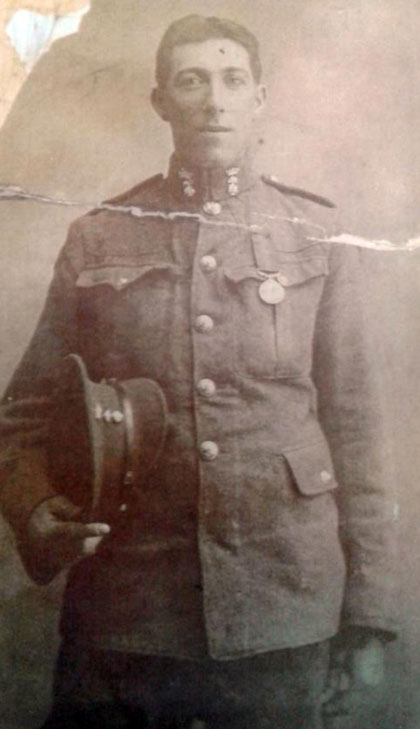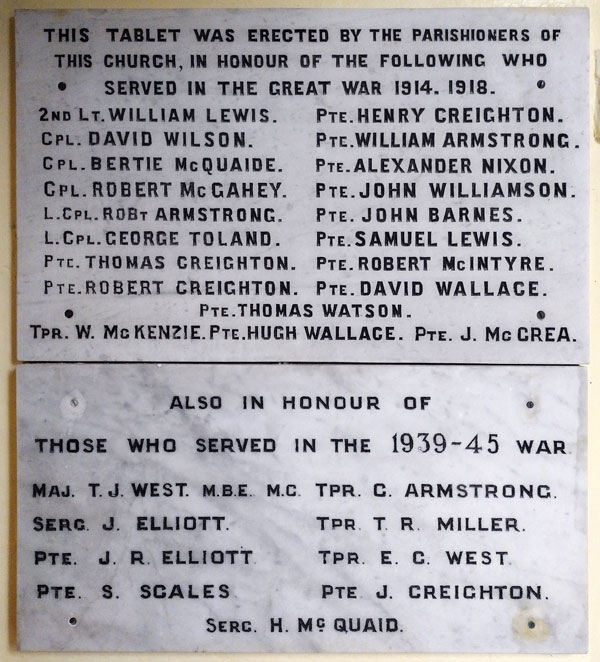Lance Corporal Robert Armstrong, DCM

Robert Armstrong was born on 29 March 1893 at Coolcran, Tempo, County Fermanagh, one of at least three children of Mary Jane Armstrong. At the time of the 1911 Census he was living at Glassdrumman, Ballyreagh, County Fermanagh, with an uncle, an aunt and his two siblings, and working as a farm labourer.
Armstrong enlisted in the North Irish Horse between 16 and 23 February 1912 (No.674).
He embarked for France on 20 August 1914 with C Squadron, seeing action in the Retreat from Mons and Advance to the Aisne. C Squadron then served as corps headquarters cavalry until April 1915, when it was attached as divisional cavalry to the 3rd Division. In June 1916 it joined with F Squadron and the 6th (Inniskilling) Dragoons Service Squadron to form the 2nd North Irish Horse Regiment, attached as corps cavalry to X Corps.
In September the following year the 2nd NIH Regiment was dismounted and most of its officers and men were transferred to the 9th (Service) Battalion, Royal Irish Fusiliers (re-named the 9th (North Irish Horse) Battalion. Armstrong must have been ill or employed elsewhere at the time, as he did not join the battalion until 1 January 1918, when he was issued a new regmental number – 46195.
He was wounded twice during the Advance to Victory offensive from August to November 1918.
On 16 October 1918 the battalion took part in an action designed to secure a bridgehead over the River Lys at Courtrai, in Belgium. The battalion war diary describes the day as follows:
Moved to Heule via Moorseele and Gulleghem. Battalion formed up between G.23.d.6.5 and G.24.a.30.00. A and B Companies in front line, A on right, C in support, and D in reserve in readiness for attack. Enemy artillery was very quiet. Patrols of the 9th Royal Inniskilling Fusiliers informed us that country was clear of enemy up to River Lys but under artillery barrage we attacked at 05.35. ... The Barrage was poor and short, causing three casualties. No opposition was met with except one machine-gun on railway at H.25.d, which was dealt with. Battalion reached the river, taking up positions commanding the opposite bank. The bridge at H.25.d.3.6 was destroyed and the railway bridge at H.25.c partially so at the opposite bank. C Company formed a defensive flank along railway in G.30.b, and D stayed at G.24.d. The houses contained numbers of civilians. Touch was kept with 12th Royal Irish Rifles on our left. At 14.00 under cover of smoke screen from rifle smoke bombs and artillery supported by trench mortars a section of Royal Engineers bridged the river and 2nd Lieutenants Steele and Logan with party thirty Other Ranks (D Company) crossed and took up positions at H.25.d.30.50 and on the main street and near the bank to cover the bridge. The smoke screen did not last long enough, however, and the bridge being detected, came under machine-gun fire from railway about H.31.a.80.60 and was partly destroyed. The Royal Engineers section had three Officers and about a dozen casualties and were unable to complete the bridge, leaving our men cut off on the opposite side. This party knocked out two machine-guns and captured six prisoners. At 6pm under cover of night it withdrew, coming across by one of the boats. ... Total casualties for the day were 2nd Lieutenant Inglis wounded, one Other Ranks killed and 24 Other Ranks wounded.
Armstrong was one of those involved in the river crossing, and was later awarded a Distinguished Conduct Medal. His medal citation reads:
On 16th October, 1918, at the crossing of the Lys Canal at Courtrai, he was in command of a Lewis-gun section which he took across in the first boat under machine-gun barrage, having volunteered for the job. By getting his gun into position on the other side of the canal he was able to cover the remainder of the party. He personally fired the gun and put out of action two enemy, machine guns. When the enemy were massing for a counter-attack he crossed a main street to get into a position from which he could fire and disperse the enemy, inflicting many casualties. Throughout the day he showed a splendid fighting-spirit.
Armstrong was discharged 11 March 1919.
After the war he returned home. Records show that in 1938 he was living at 34 Donore Street, Belfast.
His name is included on the Tempo Church of Ireland Roll of Honour.

Image of the Tempo Honour Roll kindly provided by Nigel Henderson, Researcher at History Hub Ulster. Image of Armstrong kindly provided by Nick Metcalfe.
This page last updated 30 March 2024.
